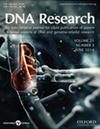对最近描述的五个CUG-Ser分支的基因组分析揭示了假丝酵母菌在假丝酵母菌种复合体中作为一个具有致病潜力的新杂交谱系
IF 3.9
2区 生物学
Q1 GENETICS & HEREDITY
引用次数: 3
摘要
摘要假丝酵母菌副酵母菌群包括三个重要的致病菌种:敏感型假丝酵母菌副酵母菌、矫形假丝酵母菌和假丝酵母菌。迄今为止测序的大部分直骨弧菌和所有转骨弧菌分离株都是杂交种,大多数亲本谱系仍未确定。这导致了一种假设,即具有致病潜力的杂交种是由在环境中茁壮成长的非致病谱系的杂交形成的。为了寻找缺失的杂交亲本,并为了更好地了解物种复合体的进化,我们对从环境中分离出来的五个近亲:假假念珠菌、假假念珠菌、氧假念珠菌、边缘念珠菌和假念珠菌进行了基因组测序、组装和分析。我们发现念珠菌种线粒体基因组的线性构象多次独立出现。此外,我们的分析排除了这些物种参与上述杂交的可能性,但确定了C. theae是物种复合体中的另一个杂交物种。重要的是,C. theae最近与一例感染有关,我们也发现了这种临床分离物的杂交性质。总之,我们的结果加强了杂交在念珠菌物种中广泛存在的假设,并且可能有助于出现具有机会致病性行为的谱系。本文章由计算机程序翻译,如有差异,请以英文原文为准。
Genome analysis of five recently described species of the CUG-Ser clade uncovers Candida theae as a new hybrid lineage with pathogenic potential in the Candida parapsilosis species complex
Abstract Candida parapsilosis species complex comprises three important pathogenic species: Candida parapsilosis sensu stricto, Candida orthopsilosis and Candida metapsilosis. The majority of C. orthopsilosis and all C. metapsilosis isolates sequenced thus far are hybrids, and most of the parental lineages remain unidentified. This led to the hypothesis that hybrids with pathogenic potential were formed by the hybridization of non-pathogenic lineages that thrive in the environment. In a search for the missing hybrid parentals, and aiming to get a better understanding of the evolution of the species complex, we sequenced, assembled and analysed the genome of five close relatives isolated from the environment: Candida jiufengensis, Candida pseudojiufengensis, Candida oxycetoniae, Candida margitis and Candida theae. We found that the linear conformation of mitochondrial genomes in Candida species emerged multiple times independently. Furthermore, our analyses discarded the possible involvement of these species in the mentioned hybridizations, but identified C. theae as an additional hybrid in the species complex. Importantly, C. theae was recently associated with a case of infection, and we also uncovered the hybrid nature of this clinical isolate. Altogether, our results reinforce the hypothesis that hybridization is widespread among Candida species, and potentially contributes to the emergence of lineages with opportunistic pathogenic behaviour.
求助全文
通过发布文献求助,成功后即可免费获取论文全文。
去求助
来源期刊

DNA Research
生物-遗传学
CiteScore
6.00
自引率
4.90%
发文量
39
审稿时长
4.5 months
期刊介绍:
DNA Research is an internationally peer-reviewed journal which aims at publishing papers of highest quality in broad aspects of DNA and genome-related research. Emphasis will be made on the following subjects: 1) Sequencing and characterization of genomes/important genomic regions, 2) Comprehensive analysis of the functions of genes, gene families and genomes, 3) Techniques and equipments useful for structural and functional analysis of genes, gene families and genomes, 4) Computer algorithms and/or their applications relevant to structural and functional analysis of genes and genomes. The journal also welcomes novel findings in other scientific disciplines related to genomes.
 求助内容:
求助内容: 应助结果提醒方式:
应助结果提醒方式:


